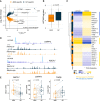Unique role for lncRNA HOTAIR in defining depot-specific gene expression patterns in human adipose-derived stem cells
- PMID: 35618313
- PMCID: PMC9186385
- DOI: 10.1101/gad.349393.122
Unique role for lncRNA HOTAIR in defining depot-specific gene expression patterns in human adipose-derived stem cells
Abstract
Accumulation of fat above the waist is an important risk factor in developing obesity-related comorbidities independently of BMI or total fat mass. Deciphering the gene regulatory programs of the adipose tissue precursor cells within upper body or abdominal (ABD) and lower body or gluteofemoral (GF) depots is important to understand their differential capacity for lipid accumulation, maturation, and disease risk. Previous studies identified the HOX transcript antisense intergenic RNA (HOTAIR) as a GF-specific lncRNA; however, its role in adipose tissue biology is still unclear. Using three different approaches (silencing of HOTAIR in GF human adipose-derived stem cells [GF hASCs], overexpression of HOTAIR in ABD hASCs, and ChIRP-seq) to localize HOTAIR binding in GF hASC chromatin, we found that HOTAIR binds and modulates expression, both positively and negatively, of genes involved in adipose tissue-specific pathways, including adipogenesis. We further demonstrate a direct interaction between HOTAIR and genes with high RNAPII binding in their gene bodies, especially at their 3' ends or transcription end sites. Computational analysis suggests HOTAIR binds preferentially to the 3' ends of genes containing predicted strong RNA-RNA interactions with HOTAIR. Together, these results reveal a unique function for HOTAIR in hASC depot-specific regulation of gene expression.
Keywords: HOTAIR; RNAPII; RNA–RNA interaction; adipose-derived stem cells; fat distribution; subcutaneous adipose tissue; transcriptome.
© 2022 Erdos et al.; Published by Cold Spring Harbor Laboratory Press.
Figures






References
-
- Baglioni S, Cantini G, Poli G, Francalanci M, Squecco R, Di Franco A, Borgogni E, Frontera S, Nesi G, Liotta F, et al. 2012. Functional differences in visceral and subcutaneous fat pads originate from differences in the adipose stem cell. PloS one 7: e36569. 10.1371/journal.pone.0036569 - DOI - PMC - PubMed
Publication types
MeSH terms
Substances
Grants and funding
LinkOut - more resources
Full Text Sources
Molecular Biology Databases
